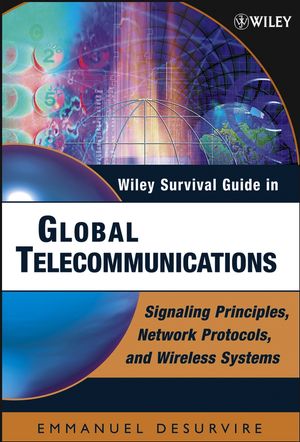Wiley Survival Guide in Global Telecommunications: Signaling Principles, Protocols, and Wireless SystemsISBN: 978-0-471-44608-8
Hardcover
440 pages
September 2004
 This is a Print-on-Demand title. It will be printed specifically to fill your order. Please allow an additional 10-15 days delivery time. The book is not returnable.
|
||||||
Forword, ix
Preface, xiii
Acronyms, xix
Introduction: The Network Cloud, 1
CHAPTER 1 Signal Modulation, Coding, Detection and Processing, 11
1.1 Waves and Analog Signals, 12
1.1.1 Sinusoids and Waveforms, 13
1.1.2 Analog Waveform Modulation, 16
1.1.3 Frequency-Division Multiplexing with Voice Channels, 19
1.2 Digital Signals and Coding, 22
1.2.1 Binary Number Representation, 23
1.2.2 Binary Coding into Waveforms, 26
1.2.3 Multilevel Coding and M-ary Modulation, 31
1.3 Analog-to-Digital Voice Conversion, 33
1.3.1 Pulse-Code Modulation, 33
1.3.2 Differential and Adaptative PCM, 36
1.3.3 Other Conversion Techniques, 38
1.4 Channel Noise, 39
1.4.1 Signal Mean and Variance, 39
1.4.2 The Gaussian or Normal Probability Distribution, 41
1.4.3 Eye Diagram of Binary Signals, 41
1.5 Binary Transmission and Detection, 44
1.5.1 Transmission System Elements, 44
1.5.2 Direct-Detection Binary Receivers, 48
1.5.3 Coherent Detection, 52
1.5.4 System Power Budget, 57
1.5.5 In-line Regeneration and Amplification, 57
1.5.6 Noise Figure of Active/Passive Transmission System Elements, 59
1.6 Error-Correction Coding, 62
1.6.1 Linear Block Codes, 63
1.6.2 Cyclic Codes, 68
1.6.3 Types of Error-Correcting Codes, 70
1.7 Channel Information Capacity, 72
1.7.1 Channel Information and Entropy, 73
1.7.2 Coding Efficiency, 75
1.7.3 Mutual Information, Equivocation and Channel Capacity, 76
1.7.4 Shannon–Hartley Law, 79
1.7.5 Bandwidth Efficiency, 82
Exercises, 85
My Vocabulary, 87
CHAPTER 2 Telephony and Data Networking, 91
2.1 Public Switched Telephone Networks (PSTN) and Services, 91
2.1.1 PSTN Topology, 92
2.1.2 Making a Phone Connection, 94
2.1.3 Interoffice Trunking and PSTN Environment, 95
2.1.4 Private Branch Exchanges (PBX) and Centrexes, 98
2.1.5 Integrated Services Digital Networks (ISDN), 98
2.2 Analog Frequency-Division Multiplexing, 101
2.2.1 FDM Hierarchy, 102
2.3 Plesiosynchronous Multiplexing, 103
2.3.1 T-Span Multiplexing and Framing, 104
2.3.2 Plesiosynchronous Digital Hierarchy, 105
2.4 Packet-Switched Networks, 109
2.4.1 The Open Systems Interconnection (OSI) Model, 112
2.4.2 X.25 and Frame Relay, 115
2.5 Local Area Networks, 118
2.5.1 Network Topology and Connectivity, 119
2.5.2 Ethernet, 122
2.5.3 Token Bus and Token Ring, 123
2.5.4 Fiber Distributed Data Interface (FDDI), 124
2.5.5 Switched Multimegabit Digital Service (SMDS), 128
Exercises, 130
My Vocabulary, 131
CHAPTER 3 An Overview of Core-Network Transmission Protocols, 133
3.1 Synchronous Digital Hierarchy (SDH) and Synchronous Optical Network (SONET) Protocols, 133
3.1.1 Limitations of Plesiosynchronous Digital Hierarchy, 134
3.1.2 SDH Framing Structure, 135
3.1.3 SONET Framing Structure, 139
3.1.4 STM-N and STS-N Framing, 142
3.1.5 SONET/SDH Network Services, 145
3.2 Asynchronous Transfer-Mode (ATM) Protocol, 147
3.2.1 ATM Cell Structure, 148
3.2.2 Virtual Channels and Virtual Paths, 150
3.2.3 ATM Protocol Reference Model (PRM), 152
3.2.4 Adaptation Layer (AAL) Service Types, 154
3.2.5 ATM Network Connection Types and Service Classes, 156
3.2.6 Mapping Protocols Over ATM and the Reverse, 158
3.3 Transmission Control (TCP) and Internet (IP) Protocols, 159
3.3.1 The TCP/IP Suite and Application Layers Stack, 160
3.3.2 The Internet and Internet Connectivities, 162
3.3.3 IP Addressing Format, 163
3.3.4 Datagram Routing, 166
3.3.5 TCP and IP Datagram/Packet Structures (IPv4/IPv6), 169
3.3.6 IP-Layer Functions, 180
3.3.7 Applications Service-Layer Functions, 182
3.3.8 E-mail Addressing, 185
3.3.9 Web-Site Addressing, 186
3.3.10 Mapping IP Over ATM, SDH/SONET, and WDM, 188
3.3.11 The Internet and www Jargon, 192
Exercises, 201
My Vocabulary, 201
CHAPTER 4 Wireless Communications, 205
4.1 Basic Physics of Radio-Wave Signals, 205
4.1.1 Generation of Electromagnetic Waves, 205
4.1.2 Radio Wavebands, 210
4.1.3 Types of Antenna, 213
4.1.4 Radio-Wave Propagation and Reception, 226
4.1.5 Multipath Interference, 235
4.1.6 Effective Noise Temperature, Noise Figure and CNR, 239
4.2 Mobile Radio Communications, 245
4.2.1 Cellular Telephone Networks, 247
4.2.2 Network Grade of Service, 250
4.2.3 Early 1G Mobile Systems and Frequency Allocations, 252
4.2.4 Global System for Mobile Communications (GSM), 256
4.2.5 From 2.5G Towards 3G Mobile Systems, 265
4.2.6 Universal Mobile Telecommunications System (UMTS), and cdma2000, 267
4.2.6 3G Services and Beyond 3G, 275
4.2.7 Wireless ATM (WATM) Networks, 277
4.3 Satellite-Based Communications, 281
4.3.1 Types of Satellite-Based Network Services, 281
4.3.2 Engineering Basics of Satellite Orbits, 283
4.3.3 Satellite Telecommunications, 306
4.3.4 High-Altitude Platform Systems (HAPS), 320
4.4 Fixed Wireless Networks, 326
4.4.1 Broadband Wireless Access (BWA), 327
4.4.2 Free-Space Optics (FSO), 332
4.4.3 Wireless LAN (WLAN) and Wi-Fi, 335
4.4.4 Personal-Area Networks (PAN): IrDA and Bluetooth, 340
4.4.5 Wireless Internet Access: WAP and i-Mode, 341
Exercises, 342
My Vocabulary, 345
Solutions to Exercises, 349
Bibliography, 383
Index, 387



